News
Toy Stitchers: A Passion for Toy Sewing Machines of Bygone Days
May 3, 2019
Long before today’s world of online ordering, children anxiously awaited the delivery of mail order catalogs. When they finally arrived, the toy section was excitedly scrutinized for the birthday or holiday wish list. Tucked in the pages of sales catalogs dating from the 1880s to the 1960s were girl-intended play items geared for “Good Little Housekeepers,” such as dolls, tea sets, play stoves, and TOY SEWING MACHINES.
With names like Little Lady, Junior Miss, American Girl, Baby, and Sotoy, the virtues of the toy sewing machine were branded to entice a purchase. Descriptions such as “instructive and practical,” “teach little daughter to sew dolly’s clothes,” “sew like mother,” and “excellent for use in kindergartens and primary schools” were selling points to justify the purchase price of 45 cents and up!
Today, the motivation to acquire these prized toy sewing machines (also known as TSMs) is varied. Some seek to replace a long-lost childhood toy or to acquire one never received in childhood. Some are smitten by the aesthetic beauty, while others are intrigued by the machine’s mechanics. History buffs appreciate the opportunity that TSMs afford to examine the changing roles of females through the twentieth century. Other TSM history detectives immerse themselves in details of a specific manufacturer, some of which were run by multi-generation family members and produced the machines for many decades through two World Wars. Still others find a toy sewing machine the perfect companion in a sewing room or as an accessory for their beloved sewing hobby. Today, passionate collectors include both women and men.
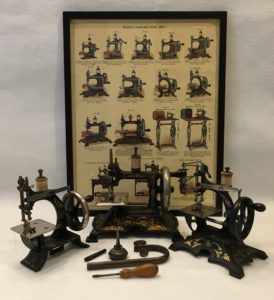
A trio of beautiful TSMs: F.W. Müller Model Numbers. 10, 15, and 20, Berlin Germany, c. 1902 and later, shown with a reproduction of a Müller leaflet 1910-1914.
So what distinguishes a toy sewing machine from its adult counterpart? One would expect the small size to be the distinguishing factor, but since some hand-operated adult machines were very small (even smaller than a typical toy model), size isn’t always a reliable determiner. TSM collectors tend to agree that the best qualifier of a bona fide toy sewing machine is the manufacturer’s intention, meaning the machine was advertised for use as a toy or for use with children. Some manufacturers specified that their products were not toys, but real sewing machines for girls. For those manufacturers, the use of the word “toy” may have implied lower quality. Some enterprising manufacturers promoted their machines to be used by both adults and children (“convenient for ladies while traveling and for little girls”), thus increasing clientele. In some cases, sewing machine companies produced both full-size adult machines as well as the smaller child’s machine, potentially trying to encourage brand loyalty for a lifetime.
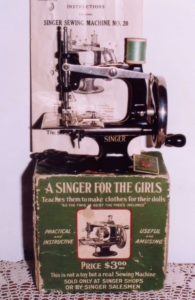
Singer No. 20, the first child’s sewing machine produced by this famous company in 1910; Trade cards show both children and women using this model.
A common feature of TSMs is that they use a single spool of thread to make a removable chain stitch by either a revolving or reciprocating hook. Most adult machines use two threads to create a more permanent lockstitch. Finally, a large majority of vintage TSMs are powered by manually turning the hand wheel, while their adult counterparts of the 1900s were treadle- or electric-powered. Early models of electric TSMs are uncommon (Thankfully, in this writer’s opinion!), and a child’s treadle is indeed a rare find compared to the typical hand-operated model.
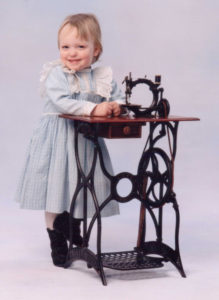
Two-year-old Hilary Abel with a Little Tot child’s treadle sewing machine. The sewing table is 21″ high. Engraved into the stitch plate is “Cleveland, O. Pat. Nov.28, 1882.”
Hundreds of toy sewing machine variations (including color, shape, size, decorative designs, manufacturer, and construction materials) were mass produced in numerous countries during the span of 75 or so years in the nineteenth and twentieth centuries. This certainly provides something for every toy sewing machine lover’s taste and budget, and are easily located with the help of today’s technology.
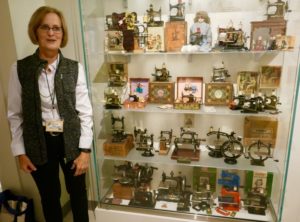
Margie Abel with her collection, on exhibit at The National Museum of Toys and Miniatures through June 3, 2019
All TSMs shown are from Margie Abel’s collection. Anyone interested in toy sewing machines is welcome to join other kindred spirits with a membership in TSII (Toy Stitchers International, Inc.), the first and largest organization of TSM collectors in the world. The Toy Stitcher is the official publication of TSII. Website: www.toystitchers.org
Margie Abel
Toy Sewing Machine Collector
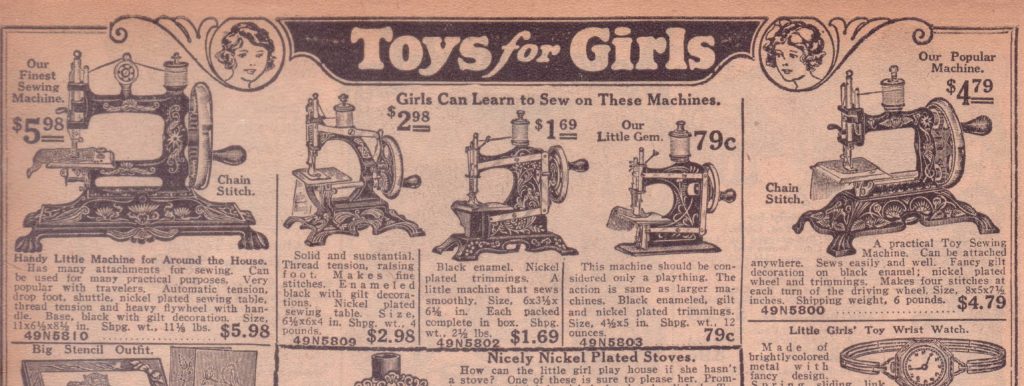

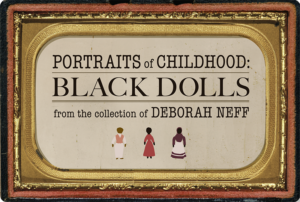
Comments